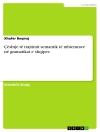Different components of grammar interact in non-trivial ways. It has been under debate what the actual range of interaction is and how we can most appropriately represent this in grammatical theory. The volume provides a general overview of various topics in the linguistics of Romance languages by examining them through the interaction of grammatical components and functions as a state-of-the-art report, but at the same time as a manual of Romance languages.
Cuprins
Table of contents
Introduction: Grammatical interfaces in Romance linguistics
Susann Fischer (Hamburg) & Christoph Gabriel (Hamburg)
I. Sound and structure
I.1 Surface sound and underlying structure: The phonetics-phonology interface
José Ignacio Hualde (University of Illinois at Urbana-Champaign) & Ioana Chitoran (Dartmouth College)
I.2 Segmental phonology and its interfaces; Marina Vigário (Lisboa)
I.3 Prosodic phonology and its interfaces; Elisabeth Delais-Roussarie (Paris Diderot & CNRS)
I.4 Romance phonology and morphology in Optimality Theory (OT); Maria-Rosa Llorret (Universitat de Barcelona)
II. Structure and meaning
II.1 Meaning of words and meaning of sentences
II. 2 Morphology and semantics: Aspect and modality; Eva-Maria Remberger (Konstanz)
& Josep Quer (Universitat Pompeu Fabra)
II.3 Romance verbal morphology in Distributed Morphology (DM)
II.4 Specificity, determiners and differential object marking in Romance
Klaus von Heusinger (Stuttgart), Georg Kaiser (Konstanz) & Elisabeth Stark (Zürich)
II.5 Agreement Restrictions in Romance; Roberta d’Alessandro (Leiden)
II.6 Auxiliary Selection in Romance; Jaume Mateu Fontanals (Universitat Autònoma de Barcelona)
III. Sound, structure, and meaning
III.1 Subjects, null subjects, and expletives; Michelle Sheehan (Cambridge)
III.2 Romance clitics; Susann Fischer & Maria Goldbach (Hamburg)
III.3 Nominalizations; Judith Meinschaefer (FU Berlin)
III.4 Information structure, prosody, and word order
Andreas Dufter (LMU München) & Christoph Gabriel (Hamburg)
III.5 Empirical approaches to information structure; Aria Adli (HU Berlin) OK
III.6 Ellipses: Gapping and VP/IP deletion
III.7 Existential and unaccusative constructions
IV. How interfaces develop and change
IV.1 Acquiring phonology and its interfaces: 2L1, L2, L3; Conxita Lleó (Hamburg)
IV.2 Acquiring syntax and its interfaces: 2L1, L2, L3
Tanja Kupisch (Lund/Hamburg)& Jason Rothman (University of Florida)
IV.3 Language acquisition and change; Esther Rinke (Frankfurt)
IV.4 Contact-induced change: The example of media lengua
IV.5 Romance-based creoles; Tonjes Veenstra (ZAS Berlin)
IV.6 Grammaticalization and pragmaticalization
Ulrich Detges (LMU München) & Richard Waltereit (Newcastle)
IV.7 Changes in the syntax-discourse interface: Information structure; Kristine Gunn Eide (Oslo)
Indices
Despre autor
Christoph Gabriel, Mainz University, Germany; Susann Fischer, Hamburg University, Germany.












